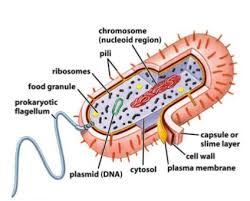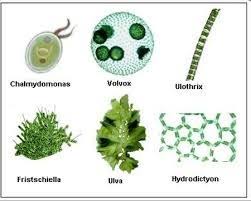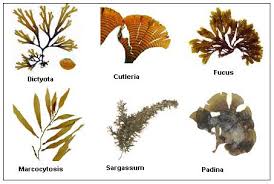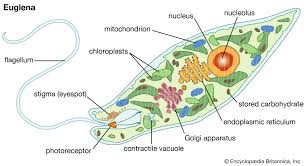From the previous two articles, it is evident that algae exhibit a great diversity in structure and reproduction. This article focuses on the classification of this diverse group. Classification refers to the grouping of organisms based on the similarities in their characteristics.
It is not far-fetched to say that organisms displaying similar morphology, life cycle, physiology, and biochemistry are genetically related from an evolutionary perspective (phylogenetically related), and thus, it is justifiable to group them together.
Algae can be classified into 8 divisions within the Kingdom Protista based on their common characteristics. This article introduces the characteristics of the different divisions of algae.
Criteria for Classifying Algae
Phycologists use a variety of criteria for classification. Generally, a combination of different characteristics is employed, including external morphology, ultrastructure, chromosome number and morphology, pigment composition, nature of cellular storage products, enzymes, isoenzymes, DNA homology, and DNA banding, among others.
As new techniques are developed, they are used to determine more precisely the relatedness (or absence of relatedness) of organisms that may otherwise appear similar.
The following outlines the key characteristics of each division of algae. It is important to note that each division is further subdivided into orders, families, genera, and species. Due to time limitations, representatives of other divisions are not included in this course, not because they are any less important in the biological world.
Prokaryotic Algae

Division CYANOPHYTA (Cyanobacteria or Blue-green Algae)
Prokaryotic algae are classified in the Division Cyanophyta. Algae in this division can be unicellular, colonial, or filamentous, with or without branches; the branching can be either “true” or “false.” Most forms are embedded in mucilaginous or gelatinous sheaths.
The composition of the cell wall is similar to that of bacterial cell walls, made up of distinctive mucopeptides and muramic acid. The ultrastructure of these cells shows no organized nucleus, mitochondria, or chloroplasts.
However, photosynthetic lamellae and 70s-type ribosomes are present in the cytoplasm. Some filamentous forms possess specialized cells called ‘heterocysts’ which are involved in nitrogen fixation.
The main photosynthetic pigments in cyanobacteria are chlorophyll a and phycobilins (phycocyanin and phycoerythrin). Several carotenoids, including β-carotene, are also present, some of which are specific to the division. Carbon is stored in the cells as glycogen granules, while nitrogen is stored as cyanophycear granules.
Other granules, such as polyphosphate granules and enzyme aggregates like carboxysomes, may also be present. Reproduction occurs through simple cell division, and cyanobacteria lack motile cells and sexual reproduction methods. Some forms contain thick-walled cells called ‘akinetes’ or spores, which serve for perennation and asexual reproduction.
Cyanobacteria are found globally in a wide range of habitats, including freshwater lakes, ponds, rivers, arctic and antarctic areas, hot water springs, brine salt pans, desert soils, and subaerial surfaces like tree trunks, building terraces, and rock surfaces.
Examples: Anacystis, Microcystis, Nostoc, Anabaena, Oscillatoria, Spirulina, Calothrix, Gleotrichia, and Scytonema.
Read Also: The Recommended Feeding Levels for Catfish at a Water temperature of 27-28°C
Eukaryotic Algae

As previously mentioned, the Kingdom Protista includes eight divisions of algae. However, some phycologists treat Bacillariophyta separately from Chrysophyta, resulting in nine divisions. For the purpose of this article, Bacillariophyta is considered a separate division, and it is described in detail below.
Division CHLOROPHYTA (Green Algae)
This division includes unicellular to multicellular forms of green algae. The multicellular forms may be filamentous, branched or unbranched, thalloid, or arranged in sheet-like structures. Some green algae are colonial in form. The cell structure is of the eukaryotic type, similar to higher plants, with a membrane-bound organized nucleus, plastids, mitochondria, and cytoplasmic ribosomes of the 80s type.
The cell wall is generally made up of cellulose, although some cells may also contain chitin.
The principal photosynthetic pigments in green algae are chlorophyll a and b, carotenoids, and xanthophylls, all located in the thylakoids.
The storage products of the cell are primarily starch, although some algae store lipids.
Reproduction occurs through both asexual and sexual methods. Asexual reproduction involves biflagellate or quadriflagellate zoospores, while gametes (used in sexual reproduction) are typically biflagellate. The flagella are anterior and of the whiplash type. Sexual reproduction includes isogamy, anisogamy, and oogamy.
Green algae are found in freshwater and marine habitats, and some may also be subaerial, living on wet soil or the bark of trees.
Examples: Chlorella, Chlamydomonas, Pediastrum, Spirogyra, Cladophora, Acetabularia, Trentepohlia, Micrasterias, and Caulerpas (Fig. 2.2).
Division PHAEOPHYTA (Brown Algae)

Brown algae exhibit the most complex morphology among the algae. They range from simple, branched filaments to large, massive bodies. The cell wall composition is complex, containing cellulose, algin, and fucoidin.
The principal photosynthetic pigments are chlorophyll a and c, along with carotenoids. Fucoxanthin, a brown pigment, is present in large quantities, giving brown algae their characteristic color by masking the green chlorophyll.
The photosynthetic storage product is mannitol, although laminarin may also be present. Rarely, lipid droplets are found in the cells.
Sexual reproduction in brown algae ranges from isogamy to oogamy. The motile swarmers have two unequal laterally inserted flagella, one larger and anterior, and the other smaller and posterior.
Most brown algae are seaweeds, with some species growing to very large sizes, commonly known as kelps. These algae are the main source of iodine, agar, and related products.
Examples: Ectocarpus, Fucus, Laminaria, Sargassum, Dictyota, Alaria, Macrocystis, Nereocystis, and Padina.
Division RHODOPHYTA (Red Algae)
Most forms of red algae are multicellular and highly branched, though a few are thalloid, and one species, Porphyridium, is unicellular. The body of some red algae may be covered with calcium carbonate incrustations.
In addition to cellulose, the cell wall of red algae contains pectin, polysulphates, esters, and a large amount of polysaccharides on the surface. These polysaccharides are the source of agar and carrageenans. Certain red algae, such as coralline algae, secrete calcium carbonate around their cells, forming stiff thalli.
Coralline algae are particularly important as builders of coral reefs in tropical waters, contradicting the common belief that coral animals alone are responsible for the creation of coral reefs.
The principal photosynthetic pigments in red algae are chlorophyll a, chlorophyll d, and phycoerythrin. Some species of red algae also contain phycocyanin. The algae appear red or pink due to the large amounts of phycoerythrin, which masks the green of chlorophyll.
The food reserve in red algae cells is floridian starch. No motile cells are present at any stage of reproduction. Sexual reproduction in red algae is advanced and oogamous.
Male gametes, known as spermatia, are passively transported by water currents to the tip of the trichogyne of the female carpogonium. After fertilization, special developmental changes occur that are unique to red algae, not found in any other division of algae.
Most red algae are marine, although a few species are found in freshwater lakes, rivers, streams, and ponds. Some are epiphytic or parasitic in nature. Examples: Porphyridium (unicellular), Porphyra, Polysiphonia, Gracilaria, Gelidium, and Corallina.
Division XANTHOPHYTA (Yellow-Green Algae)
Some forms of yellow-green algae are unicellular and motile, while others are filamentous with multinucleate cells. The photosynthetic pigments include chlorophyll a, chlorophyll c, β-carotene (which is present in large amounts), and xanthophylls, giving the cells a greenish-yellow color.
The food reserves consist of lipids and chrysolaminarin, a β-1,3-linked polymer of glucose, also known as leucosin. The cell wall often consists of two overlapping halves, containing pectin, silica, and small amounts of cellulose.
Sexual reproduction is rare. The motile cells have two unequal flagella at the anterior end—one is tinsel, and the other is whiplash type (Fig. 2.5).
Yellow-green algae are widely distributed in aquatic, freshwater habitats. Some are sub-aerial, and a few are found in marine environments. Examples: Vaucheria, Botrydium.
Division CHRYSOPHYTA (Golden-Brown Algae)
Golden-brown algae are mostly unicellular or colonial; filamentous forms are rare. The motile cells have two flagella at the anterior end, which may be equal or unequal in length. The longer flagellum is covered with stiff hairs, while the shorter one is smooth. The cell wall is composed of pectin and silica or scales of carbonate, and the chloroplasts are deeply lobed.
The principal pigments in golden-brown algae are chlorophyll a, chlorophyll c, and carotenoids such as β-carotene, fucoxanthin, diatoxanthin, and neofucoxanthin.
The storage products primarily consist of oil droplets. True starch is absent, but glucan granules or leucosin are present.
Sexual reproduction is rare in this group. A common feature is the formation of resting cysts or resting spores (statospores), which have silica walls. These cysts are formed as a result of either asexual or sexual reproduction.
Golden-brown algae are distributed in marine and freshwater habitats, as well as in fast-flowing mountain streams. Marine coccolithophorides are responsible for the formation of chalk beds on the sea floor. Examples: Synura, Chromulina, Ochromonus, Mallomonas, and Dinobryon.
Read Also: Meaning of Recirculating Aquaculture System (RAS) in Fish Farming
Division EUGLENOPHYTA (Euglenoids)

Most euglenoids are simple, unicellular, motile flagellates. They lack a firm cell wall and possess characteristics similar to protozoans, such as a contractile vacuole. The cell surface is covered by a pellicle, which is a thin membrane with helical, knob-like projections. The shape of the cell changes constantly, exhibiting a unique movement known as euglenoid movement.
The chloroplasts in euglenoids vary in shape, including discoid, ribbon-like, or stellate forms. The cells are biflagellate, but only one flagellum emerges anteriorly.
Some biologists consider these algae more related to the animal kingdom and classify them as protozoans, particularly due to their unicellular nature and characteristics.
The photosynthetic pigments in the plastids include chlorophyll a, chlorophyll b, and carotenoids like β-carotene. Some euglenoids are colorless. They store food in the form of starch (paramylon), and oil droplets and polyphosphate granules are also common.
Reproduction occurs through binary fission, and many species form cysts under adverse conditions. Sexual reproduction is absent.
Euglenoids are commonly found in freshwater, brackish water, and polluted ponds, as well as temporary rainwater pools. Examples: Euglena, Trachelomonas, Phacus.
Division DINOPHYTA (Dinoflagellates)
Dinoflagellates have a cell wall consisting of cellulose plates, which are located inside the plasma membrane. Some species may also have additional body scales. The cell structure is complex, with most forms being unicellular and motile. Several dinoflagellates, such as Noctiluca, are luminescent, glowing in the dark when disturbed.
These algae contain chlorophyll a and c, along with distinctive carotenoids that are specific to dinoflagellates. Their reserve foods are primarily starch and oil.
Asexual reproduction occurs by cell division, with the parent cell dividing into a number of aplanospores, zoospores, or non-motile cells. Sexual reproduction has been reported, and gametes are smaller than the vegetative cells. Fusion is isogamous, and cyst formation may occur with or without gametic fusion.
Dinoflagellates are primarily marine phytoplankton, and some species form “red tide” blooms. Many are symbionts in marine animals like corals (zooxanthellae). Examples: Noctiluca, Gonyaulax, Peridinium, Ceratium.
Division CRYPTOPHYTA (Cryptomonads)
Cryptomonads are unicellular and motile, and when alive, they appear brown in color. Several genera have animal-like morphology and modes of nutrition, with some being colorless and saprophytic in nature. The cells lack a cell wall and are ovoid, dorsiventrally flattened. They have two flagella, which are apical and unequal in length.
The chloroplasts may be either single or multiple in a cell, and in some cryptomonads, there are two large parietal chloroplasts or many disc-like ones.
The pigments include chlorophyll a, chlorophyll c, phycocyanin, phycoerythrin, and various carotenoids. The storage photosynthate is starch.
Reproduction occurs by longitudinal division of the cell, and palmelloid forms may produce zoospores. Sexual reproduction has not been reported. Examples: Cryptomonas, Chroomonas.
Division BACILLARIOPHYTA (Diatoms)
Diatoms are mostly unicellular, though some forms are colonial or filamentous. Their cell walls are silicified, consisting of two perforated overlapping plates, often highly ornamented. The chromatophores are brownish due to a high concentration of carotenoids. When cut in half, the diatom cell is made up of two parts: the larger part fits tightly over the slightly smaller part like a petri dish (Fig. 2.9).
Photosynthetic pigments include chlorophyll a and c, fucoxanthin, diatoxanthin, and diadinoxanthin. The primary storage products are oil and chrysolaminarin.
Reproduction occurs by vegetative and sexual methods. Diatom cells are diploid, unlike other algae. Sexual fusion is homothallic, meaning it occurs within individuals of the same clone. Two amoeboid gametes fuse to form a zygote, which develops into an auxospore. Fusion can be isogamous, anisogamous, or oogamous.
Diatoms are widely distributed in freshwater and marine environments, as plankton, on mud surfaces, moist rocks, and sand. They can also be epiphytic, epizoic, or endozoic. Large deposits of fossilized diatom shells, known as diatomaceous earth, are mined for use in various industries.Examples: Navicula, Cymbella, Coscinodiscus, Diatoma, Fragilaria.
Algae can be classified into two major types: prokaryotes and eukaryotes, based on the differences in cell ultrastructure. Although cyanobacteria (blue-green algae) are related to bacteria, they are grouped with other algae due to similarities in pigment composition and the presence of oxygenic photosynthesis.
Eukaryotic algae are classified into 9 divisions, each sharing many common characteristics. All photosynthetic algae contain chlorophyll a and β-carotene, but other pigments may vary.
The relationship between different groups of algae is complex, with some divisions sharing certain pigments, such as the phycobilins (phycocyanin and phycoerythrin) found in Cyanophyta, Rhodophyta, and Cryptophyta.
i. Green algae (Division Chlorophyta) include unicellular, colonial, and filamentous forms. They store food as starch and contain chlorophyll a, b, β-carotene, and xanthophylls. Though euglenoids also contain chlorophyll a and b, they differ significantly from green algae.
ii. Brown algae (Division Phaeophyta) are mostly marine, large, complex, and multicellular. Their chlorophylls are masked by the brown pigment fucoxanthin, and food is stored as oil and laminarin.
iii. Red algae (Division Rhodophyta) are marine, multicellular, and filamentous. Their chlorophylls are masked by phycobilins, and food is stored as floridian starch.
iv. Members of Xanthophyta, Chrysophyta, Dinophyta, and Cryptophyta are primarily unicellular and contain chlorophyll a and c, collectively known as chromophytes.
In Xanthophyta, Chrysophyta, and Dinophyta, the cell wall is made of cellulose or is absent. In Euglenophyta and Cryptophyta, the cell wall is absent.
Do you have any questions, suggestions, or contributions? If so, please feel free to use the comment box below to share your thoughts. We also encourage you to kindly share this information with others who might benefit from it. Since we can’t reach everyone at once, we truly appreciate your help in spreading the word. Thank you so much for your support and for sharing!

